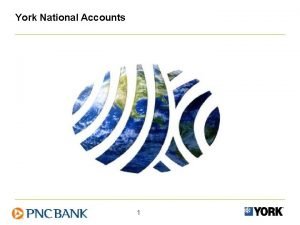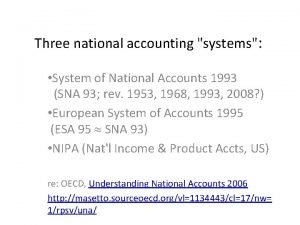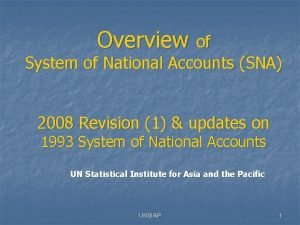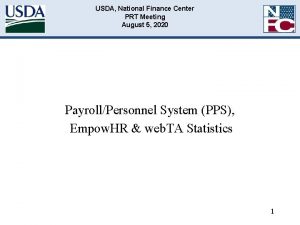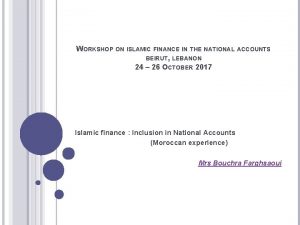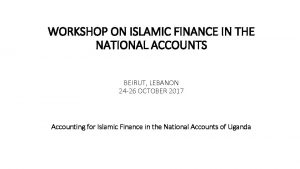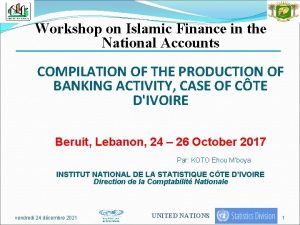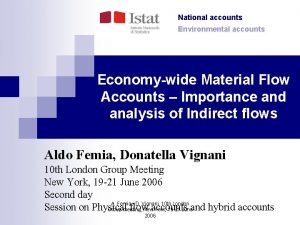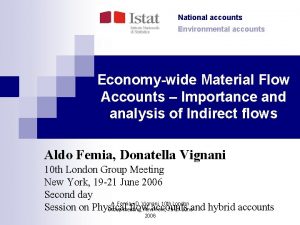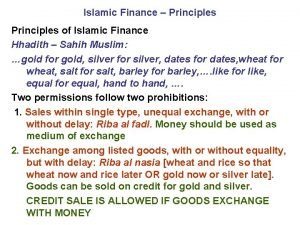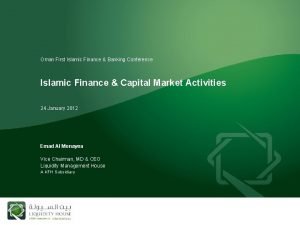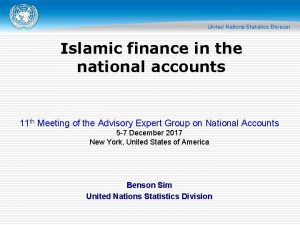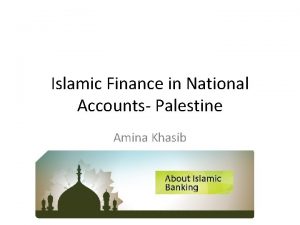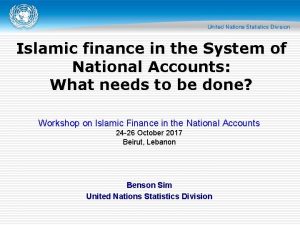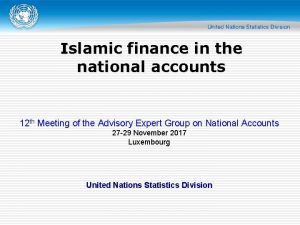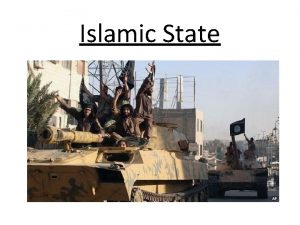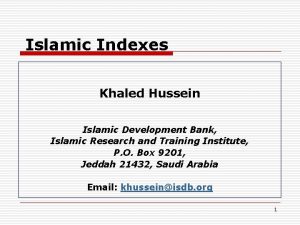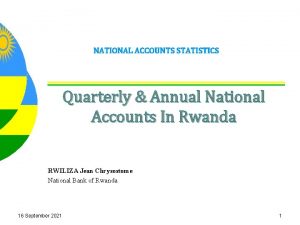WORKSHOP ON ISLAMIC FINANCE IN THE NATIONAL ACCOUNTS





















- Slides: 21

WORKSHOP ON ISLAMIC FINANCE IN THE NATIONAL ACCOUNTS BEIRUT, LEBANON 24 – 26 OCTOBER 2017 Islamic finance : Inclusion in National Accounts (Moroccan experience) Mrs Bouchra Farghsaoui

OUTLINE Introduction Overview of Moroccan National Accounts; A) Alignement with SNA recommandations; B) Output of National accounts in Morocco; Financial corporations: A) Subsectors; B) data sources; C) Impact of introduction of the new SNA recommandations; Islamic finance : A) Birth and evolution of islamic banks in Morocco; B) Accounting information required; C) Insertion in National Accounts;

INTRODUCTION Islamic finance, banking and other form of islamic have developped rapidly in some countries; It is large enough to affect the quality of their national accounts, monetary and financial statistics, and indicators of the structure and soundness of national financial systems. The SNA has not provided guidance to national compilers on methods to compile national accounts statistics for Islamic banking and finance,

OVERVEW OF MOROCCAN NATIONAL ACCOUNTS National accounts play an important role in economic statistics. Their compilation is currently based on a globally recognized system of national accounts; Morocco has made significant advances in the production of national accounts and in the implementation of international recommendations and standards; However, the nature and number of accounts and tables to be constructed in accordance with those recommended by the system depend on the availability of data from the National Statistical System (NSS).

1993 SNA serie of accounts (1998 -2007) serie of accounts (1960 -1976) 1953 B. 200 7 B. 198 0 B. 196 0 B. 199 8 some macroeconomic indicators and aggregates 1968 SNA serie of accounts (1980 -1995) 2008 SNA serie of accounts (2007 - 2012)

REASONS OF CHANGING THE BASE YEAR 1/ The first reason has a methodological aspect, we have to make the implementation of 2008 SNA requirements and take into account the new national and international classification. 2/ The second reason is related to the structural changes of economic activity, it’s due to the emergence of new activities and products and changes in consumption, production and marketing habits and product quality. 3/ The third reason is to improve the quality of accounts because it may be degraded by the remotness of the base year. 4/ The fourth reason is to improve the completeness of data base, we have to add some institutions so we introduced the micro credit associations, exchange offices and offshore banks in financial corporation sectors.

Data Sources: • - Which have an accouting, • - others without accounting. (informal sector) • Household Living Standard Survey, • Household Consumption and Expenditure Survey. The general government • The Business Survey : Households Business Statistical surveys : • Investment Survey.

Data Sources (2): Annual surveys : • Annual Employment survey, • Annual survey on processing industries, • Annual crop and livestock surveys, • Annual surveys on construction, trade and services. Statistical indices : • Index of Industrial Production, • Mining Production Index, • Foreign Trade Indices, • Consumer Price Index. Administrative data • International trade and balance of payments statistics, • Annual Report of insurance companies, pension funds, • The Bank Summary report, • Summary of Offshore Banking,

OUTPUT OF NATIONAL OCCOUNTS INMOROCCO Annual national accounts: � Accounts of Goods and Services: aggregates in volume and value, production accounts by branch, GDP and other agregates… � Institutional Sector Accounts: the sequence of accounts of economic agents: S 11, S 12, S 13, S 14, S 15 and S 2; also the Table of integrated economic accounts and the financial Operations Table; Quarterly national accounts; Régional accounts; Tourism satellite account;

FINANCIAL CORPORATIONS Financial corporations consist of all resident corporations that are pricipally engaged in providing financial services, includig insurance and pension funding services, to other institutional units. Subsectors: � � � Central bank : S 121; Deposit taking corporations: S 122; Other financial intermediaaries : S 123; Financial auxiliaires : S 124; Insurance corporations and pension funds : S 125;

Overview of FISIM: Ø Is indirect measure of the value of financial intermediation services provided but for which financial institutions do not charge explicitly, Ø Needs to be imputed because no explicit fees are charged, Ø Partitions actual bank interest into : SNA interest and FISIM, Ø Applies to loans and deposits provided by, or deposited with, financial institutions.

FISIM output : Ø The 2008 SNA calculates the output of FISIM on loans (VL) and deposits (Vd) only, using a reference rate (rr). (we use an interbank lending rates as a reference rate), Ø Assuming that these loans and deposits attract interest rates of r. L and rd respectively, the output of FISIM should be calculated according to the formula : (r. L - rr) VL + (rr - rd) Vd. Ø The 1993 SNA calculated FISIM as the difference between property income receivable and interest payable. Ø Output of FISIM should be allocated between users (lenders as well as borrowers) treating the allocated amounts as : * Intermediate consumption (53, 6%/ 2007), *Final consumption (44, 9 %/2007) and Exports (1, 5% /2007 ),

Output of central bank: � Services ed by the ceproducntral bank are identified in three broad groups: § financial intermediation, § monetary policy services, § supervisory services - overseeing financial corporations. Output of rinsurance: These services are treated in the same way as direct insurance so, in national accounts: § Output = premiums, plus premiums supplement (property income on reserves), less claims.

ISLAMIC FINANCE A) Birth and evolution of islamic banks in Morocco: Morocco has adopted progressive and prudent approch to introduce islamic or « alternative » financial projects : 2007 : Bank al maghrib authorised only conventional banks to offer 3 islamic financial products. �( Ijara leasing product, Murabaha contract to by and re-sell underlying goods and Musharaka co- ownership financing structure).

2010: Approval of the implementation of the first islamic financial institution in Morocco: (Dar al safa), it is an islamic finance company specialized in the marketing of islamic finance; 2014: Morocco’s governement adopted a draft bill to regulate islamic banks and allows for sukuks sales; 2017: recently in june 2017, Morocco has gained new category of banks whose products and services must comply with sharia rules;

Conventional or islamic banks may offer two categories of islamic operations and products to their customers: � 1 - traditional banking operations; � 2 - islamic operations and services, such as investment deposits and financing products including: � Mourabaha: acontract for the sale of real or personal property between the bank and its customer; � Ijara: a contractfor the rental of real or personal property between the bank and its customer; � Mousharaka: participation by the bank in a project in order to make aprofit;

� Moudaraba: a contract that brings one or more islamic banks who provide the capital into contact with one or more suppliers who provide their labour in order to complete a project that generates profit; � Salam: a contract pursuant to which one of the parties pays in advance the full price for goods and the other party, as the case may be, agrees to deliver a defined quantity of those goods within an agreed time frame; � Istisna’a: a business contract pursuant to which one party asks another to manufacture or build it something in consideration of remuneration tfat is payable in advance, in tranches or in future.

ISLAMIC BANKS IN NATIONAL ACCOUNT Data sources Islamic banks , like conventional banks, may , once approval has been obtained from Bank Almaghrib the central bank , offer these products to customers who are individuals. the Islamic and other conventional banks operate under the supervision of the central bank; the latter provides us a consolidated statement of accounts. otherwise, if there is a need, we can ask for the individual financial statements of the banks.

ISLAMIC BANKS IN NATIONAL ACCOUNT Since the work of change of the base year has already begun, the lists of all institutional units are in the process of being revised, a reflection must be focused on the definition and delimitation of the scope covered by Islamic banks; the contribution of the central bank, which represents the guardianship in the field, is of great important; it is also believed that the texts and conventions between these banks and conventional banks will be very useful in determining the status of these units from an accounting point of view.

ISLAMIC BANKS IN NATIONAL ACCOUNT In 2008 SNA, FISIM is calculated only on loan and depositlike instruments handled by banks and similar financial institutions; Specific Islamic instruments are used with names and financial flows that do not readily fit the standard SNA financial instrument classification Specific practices, related to the procedures for measuring output of financial intermediation: Islamic Banks are not funded by conventional deposit accounts, � but mostly by accounts in which returns or losses are shared between the bank and the depositor/investor � these are called Profit-Sharing Investment Accounts � (PSIA), � and the depositors are described as Investment Account Holders (IAH):

 Modaraba
Modaraba Derivatives in islamic finance
Derivatives in islamic finance York national accounts
York national accounts The national income and product accounts
The national income and product accounts What is system of national accounts
What is system of national accounts Sna 2008
Sna 2008 Advisory expert group on national accounts
Advisory expert group on national accounts National finance commission
National finance commission National finance commission
National finance commission National finance center
National finance center Davis contractors v fareham udc
Davis contractors v fareham udc Hình ảnh bộ gõ cơ thể búng tay
Hình ảnh bộ gõ cơ thể búng tay Ng-html
Ng-html Bổ thể
Bổ thể Tỉ lệ cơ thể trẻ em
Tỉ lệ cơ thể trẻ em Voi kéo gỗ như thế nào
Voi kéo gỗ như thế nào Tư thế worm breton là gì
Tư thế worm breton là gì Hát lên người ơi alleluia
Hát lên người ơi alleluia Môn thể thao bắt đầu bằng từ chạy
Môn thể thao bắt đầu bằng từ chạy Thế nào là hệ số cao nhất
Thế nào là hệ số cao nhất Các châu lục và đại dương trên thế giới
Các châu lục và đại dương trên thế giới Công thức tính độ biến thiên đông lượng
Công thức tính độ biến thiên đông lượng


